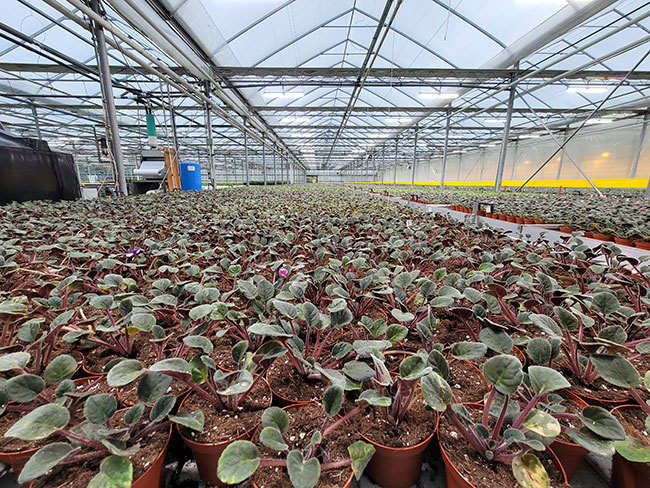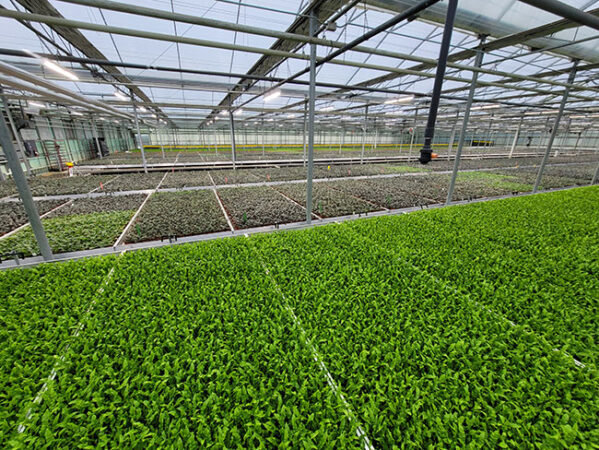
Features
Technology update: Nanobubble generators
Reduced cycle time, larger root masses and other benefits seen at Hamilton, Ontario greenhouse
June 30, 2023 By Treena Hein
 African Violets at Harster Greenhouses
in Hamilton, Ont.
Photos: Moleaer
African Violets at Harster Greenhouses
in Hamilton, Ont.
Photos: Moleaer Many greenhouse operators are hearing about the benefits of nanobubble generators. Their use is increasing in the international greenhouse sector in both ornamental and food crop production due to the wide range of benefits that they provide. Nanobubble treatment is also actively being used in many types of water pollution remediation scenarios.
If you haven’t heard of nanobubble technology, it is what it sounds like. The bubble generating machine is hooked up directly to a greenhouse or horticulture irrigation system or a reservoir of some type, including small natural bodies of water. Bubbles with a diameter less than 400 nanometres — roughly 2,500-times smaller than a grain of salt — are continually produced. They are generated at concentrations typically in the hundreds-of-millions per millilitre and move uniformly within liquids such as water.
In agriculture, the technology is promoted as a chemical-free, cost-efficient and sustainable way to improve water quality and boost plant performance.
As it relates to plant growth, nanobubbles super-oxygenate water, boosting dissolved oxygen (DO) levels to between 19 to 30 mg/l. As all producers are aware, higher oxygen levels not only discourage the growth of rot waterborne pathogens such as Pythium in the root zone but promote the growth of beneficial microbes. Also, higher levels of oxygen in the water that is taken up by plant root cells drives a higher metabolic rate and faster nutrient absorption, all resulting in faster root growth and larger root systems.
In terms of water and irrigation pipe disinfection, through their constant movement and production of reactive oxygen species (oxidation) on eventual collapse, nanobubbles both physically abrade biofilm and prevent its reformation. The bubbles also lyse algae and any microbes present in the irrigation system. These higher water quality levels mean growers can reduce the volume of disinfectant chemicals, like peroxide, they use. In a reservoir, the use of nanobubbles results in savings as there is less need for media filter management.
Nanobubble generators are not cheap but the benefits are quite immediate and cost return is swift.
ROI was reached, for example, at Harster Greenhouses in Hamilton, Ont. in less than a year for each of their four generators.
“We had one from a South Korean firm but switched to Moleaer because they are based in North America, so any issues might be more easily solved, and also Moleaer units aren’t as expensive,” says Yannick Harster, who owns the 15-acre operation with his parents Andre and Pascal.
The Korea company is called Newmantech. Others nanobubble generator firms include IGS Asia Pacific Water Solutions of Australia, Agrona Group of the Netherlands, Nanobble of India and Acniti of Japan.
Giving nanobubbles a try
At Harster, which opened in 1976, the main crop is African violets, but they also grow many other ornamental plants in smaller amounts, from orchids, cactus and turtlevine to cyclamen and poinsettia.
Prior to using nanobubbles, the growth cycle of violets was approximately two months from plugs. As is normally expected, the cycle was generally a little inconsistent due to seasonal natural and artificial light differences. Harster and his Head Grower, Bart Kouwenberg, also wanted their top-quality plants to be a little more resilient, as the transport process from their greenhouses to stores can be as long as five days. They had heard that nanobubbles would improve plant performance while also providing water quality benefits.
“We bought the first Moleaer generator about four years ago and one more every year since,” said Harster. “We have one unit for our main irrigation reservoir and one for our main irrigation tank and violets propagation tank. These are stationary, and we also have another unit that we move around to our smaller propagation tanks for different crops.” He notes that these generators produce a DO of between 19-24 ppm year-round.
Harster said once nanobubble treatment started, the growth cycle for violets became consistent and was reduced by about 20 per cent, allowing for many more crop turns. The plants were bigger with more root mass, Harster said, and fertilizer use decreased by about 10 per cent.
“The nanobubbles allow them to get more out of what we give them,” he explains. “I’m not sure how much fertilizer use has been reduced with our other crops, but there has been a reduction with those as well.”
On the disease front, there has been some reduction in incidence of Pythium and fusarium growth, but disinfection actions like tank cleaning and application of peroxide have also been adjusted over the years, so Harster admits that it is hard to tell how much is due to this or that.
“But there’s definitely less biofilm,” he reports.
Overall, he said, they are producing the same top-quality plants but with less input costs and achieving more profits with the shorter cycle time.
“Now that we’ve used nanobubbles, it’s part of our greenhouse operation and it’s not something we want to do without,” he concludes.
“I think that growers particularly with crops with less than three-month to four-month turnover would really benefit, but I think you’ll see the same plant performance results with longer crops.”

Since Harster introduced nanobubble technology to the operation, they are reporting lower input costs and higher profits as a result.
Other results
Moleaer provided case study details from two other ornamental greenhouse operations, and also offers many horticulture and water remediation case studies on the website.
Meewisse Roses, based in the Netherlands, produces about 13-million premium rose plants per year, and installed Moleaer tech a few years ago.
“The cultivation of a rose crop on rockwool is special in a way, because the rose is a perennial shrub,” said owner Tom Meewisse in the case study. “That means the slab will often get completely covered with roots and become more compacted, causing less aeration into the lower parts of the mat. The amount of oxygen that can be delivered through the irrigation water thus becomes particularly important. I was rather curious to see if we could improve this.”
Meewisse found their Moleaer generator maintained 35 to 40 mg/l DO levels.
“Pathogen analyses of the water showed increasingly lower amounts of fusarium and Pythium,” said Meewisse. “Not that those values were high to begin with, since we also use a UV disinfector, but the nanobubbles still made quite a big difference. Moleaer also had weekly plant sap analysis carried out, which showed that calcium uptake was higher in the weeks that we applied oxygen enrichment, and lower when the nanobubble generator was switched off.”
He added, “for me, it’s about the complete picture that I get from all this data: that nanobubbles contribute to healthier water and a root zone that’s richer in dissolved oxygen, which contributes positively to cultivation. It’s difficult to see it in the crop directly, but overall, higher oxygen levels, cleaner irrigation lines and better calcium uptake convinced me to continue with the Moleaer unit.”
Klondike Gardens in the Netherlands installed two Moleaer generators for their specialized gerbera daisy operation several years ago. To keep the water system clean and in order to suppress pathogens, the owners had alternately used chlorine or hydrogen peroxide in their drip irrigation water, and the drain water was also disinfected with UV. Despite this, they lost gerbera plants due to disease and harvest stress.
The nanobubbles increased Klondike’s DO from 7 ppm to an average of 25 ppm. After the system had been running for a few months, the owners saw a difference in plant vigor and improved root development. Plant loss to disease decreased, while heat stress resistance increased during the summer. Overall water system hygiene also improved.
Greenhouse Canada welcomes contact from others in the Canadian greenhouse industry who have tried nanobubble technology.
Print this page